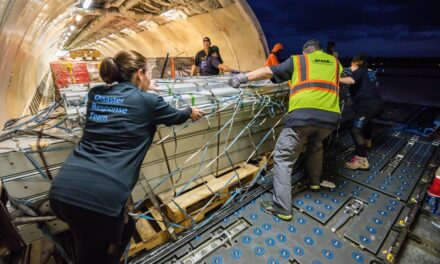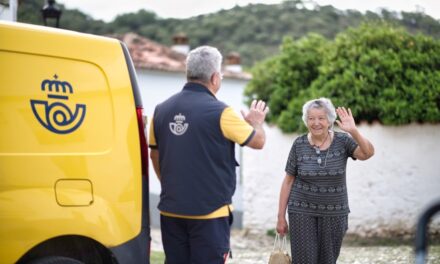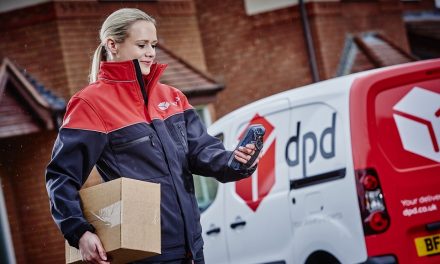
Metamorphosis of UK Parcels Market

Michael Herson of London-based strategy consultancy, The Strategy Works, finds that these are exciting and challenging times for parcel operators as they compete to sharpen their offering in an internet fuelled growth market. The £8.3bn UK Domestic Parcels market was undergoing rapid transformation even before the high profile demise of City Link on Christmas Day last year. The sea of media coverage that followed (including a BBC TV documentary) raised awareness of the whole sector, shifting the spotlight onto the business models of the remaining players, as they seek to satisfy an increasingly demanding mix of customers whilst keeping a tight lid on costs.
To better understand these market forces, TSW has interviewed two fast growing companies in the market – GeoPost and Hermes – and the market leader – Royal Mail Group (RMG) with its twin brands Royal Mail and Parcelforce Worldwide.
Customers / Market Definitions
Anyone operating in this market interfaces with two sets of ‘customers’ – the retailer who ships the parcel and the consumer – its end recipient. Both are equally important, because whilst price sensitivity is a key part of the equation, differentiation is increasingly about the whole ‘delivery experience’.
As Tim Jones – Director of Marketing for both of GeoPost’s brands – DPD and Interlink -succinctly puts it: “….we’ve got two audiences to keep happy”. Martijn de Lange Operations Director of Hermes agrees: “I think historically probably it’s the retailer, but more and more important to us and to our retailers is that we are delivering a superior end customer experience”
This particularly rings true in the B2C market segment (c£2.9bn), now accounting for 34% of the total domestic parcels market value vs. the B2B market (c£4.5bn) at 54% of the market. Just 6 years ago, B2B parcels dominated with 74% of the UK market value vs only 15% for B2C, so the gap has narrowed significantly (Source: Apex Insight). However the operators need to move many more parcels in the B2C sector to generate like for like revenues with the B2B sector, illustrating the need to invest in infrastructure and control costs.
Of the three companies profiled in this article both GeoPost and Royal Mail have important B2B and B2C traffic streams, whereas Hermes, which was born out of the Grattan and Freemans mail order empire, now owned by Otto in Germany, is almost entirely focussed on the B2C market. The C2C market (consumers shipping to each other) makes up the balance of around 8%. International (UK retailers exporting on line) is another growth segment but that is not profiled in this article.
Branding
Both GeoPost and Hermes focus their twin brands on different segments of their business:
“Hermes is the brand we use for our big retailers and ‘My Hermes’ is for our smaller retailers” explains De Lange; Similarly “DPD typically services large corporate shippers and Interlink services small to medium enterprises” confirms Jones.
“Royal Mail is ahead of the curve on branding, achieving number 15 ranking out of the top 20 UK ‘Business Superbrands’ in their 2015 survey” points out Nick Landon, Managing Director of Royal Mail Parcels. “Our capability to consistently deliver to every UK address every day, at broadly the same time, enhances our brand approval rating”
As the parcels companies improve the end delivery experience so their visible branding assumes greater significance. DPD / Interlink and Parcelforce Worldwide both prefer the ‘man with a van model’. “The Geopost model is based on a mixture of owner drivers who have a routed franchise and employed drivers.” explains Jones. In contrast Hermes prefer the ‘lifestyle courier’ model where goods are delivered in unbranded private cars. Apart from being cost effective (a courier can typically deliver 60 parcels per day) Hermes feel this model is well suited to their B2C customer base as De Lange explains:
“The couriers are local people so they’re very close to their customers …….so that means that if people are not home, the courier might know where to drop it off, so you get a very high first time delivery hit rate” But as the C2C business grows, Hermes recognise that branding is becoming more important and Hermes are putting a number of initiatives in place to improve awareness.
Multi – Channel Options
A combination of rapid IT advances and ever more demanding customers is driving the market providers towards offering multiple choices as to where and when customers receive (and return) their parcel. De Lange of Hermes recognises this: “We are working on becoming a multi-channel operator, meaning we deliver to home, to parcel shop, to store, over a seven day week in the UK”.
Competition comes from many directions. Leading retailers have already seized the initiative by offering their own popular ‘Click & Collect’ services which effectively by-pass the parcels delivery company and eliminates the delivery charge for the end customer. Powerful on-line retailers like Amazon, have set up their own local delivery networks, effectively competing with their own suppliers. Whether motivated by security of supply or the relentless focus on customer experience this still represents a threat to the parcels operators.
Encroaching into the C2C market, eBay is testing a new service for its sellers to drop off items at their nearest Argos store, for packing and despatch. ‘Doddle’ – another new ‘final mile’ model set up in conjunction with Network Rail – has established a collect & return service at over 35 stations. Multi-channel effectively equates to a 7 day service and Sunday deliveries are now being increasingly adopted by the leading parcels operators. Hermes, with their ‘myHermes’ Sunday delivery service, and Royal Mail were the first to market in June last year closely followed by GeoPost who launched in July 2014.
Timed Delivery
Timed delivery slots are becoming the industry benchmark to which the most progressive operators aspire. GeoPost has pioneered this product with its ‘Predict‘ service which offers one hour delivery slots notified by text or email. Hermes, recognising this is an essential part of the armoury of a modern parcels operator is rolling out its ‘ Hermes ETA’ service in August this year – initially with a 4 hour delivery window and then (over time) reducing to a two hour then a one hour slot.
But the Holy Grail in this market is to offer the recipient ‘in flight options’ whereby end consumers can elect (in the final 24 hour window) to divert the parcel to another day or time slot, to a neighbour or even a parcel shop. GeoPost recognise the benefits: “What’s different about DPD and Interlink is that we give you that choice in flight so when you’ll get your ‘Predict’ notification, you can already choose the neighbour you want it delivered to and very shortly you’ll be able to choose the shop” comments Jones.
Hermes is adding this functionality to their portfolio in 2016, confirms De Lange: “We will brand it ‘Diversions’, which will give customers the choice to say, do I want it at that time or do I want it the following day or do I want it to go to a parcel shop or a neighbour or a safe place, so we’re putting that technology in.”
To compete in this growing market segment RMG launched ‘Parcelforce Select’ in January this year aimed at providing interactive services to support e-retailers. Landon explains: “Customers can better manage their parcels after placing an order, enabling them to change the date on the day of delivery, or re-direct it to a Post Office branch. Also to multiply our final mile options, RMG has just introduced its new ‘Nominate a Neighbour’ service, an idea developed internally by our employees”.
Parcel Shops
In order to offer extended hours for both deliveries and collections and provide more options to recipients who work in the day time, parcel operators are rapidly setting up their own networks of parcel shops.
Royal Mail has access to the largest UK network of parcels shops explains Landon: “Through our partnership with the Post Office we have the biggest network of any carrier. At 11,500 Post Offices it is almost double the size of our nearest competitor. A high proportion of Post Offices are increasingly open for longer hours and some on Sundays. The deep coverage of this network has now been geared up to offer a ‘click and collect’ service to our 20,000 SME contract customers”
Recognising that competitors already have sizeable networks, GeoPost is now building its own network of parcel shops (‘DPD PickUp’), as Jones outlines: “From June this year we’ll open a network of 2,500 shops to which our receivers can select to have their parcels delivered to, if not at home. The network will comprise of pharmacy groups, like Rowlands and independent and convenience stores. Consumers want choice and I think it will be important to have a shop network in your mix”.
Hermes already have double this number with a network of 5000 parcel shops as De Lange explains: “We have some really good groups, Sainsbury’s, One Stop, Co-op, Premier, Nisa, Johnson Cleaners, etc., and the rest are independents, so it’s a combination. We selected them because they are open till eight, nine, ten o’clock, so much longer opening times” .This service has proved particularly popular with Hermes’ growing C2C business (eBay sales etc.) and Hermes believes this negates the need to introduce potentially costly evening deliveries.
Retailer Cost Pressures
It’s not just the final customer who is becoming more demanding as retailers, seeking a competitive edge over each other, push parcels companies for later acceptance times (Next has recently moved to 11.00 pm) and import ‘shopping frenzy’ concepts from the USA such as ‘Black Friday’ and ‘Cyber Monday’, which create artificial peaks in consumer demand, similar to Christmas, but focussed on a single day. What this does is to pile more pressure not only on operational costs but on the infrastructure itself, as those parcel companies that cannot meet the retailers’ surges in demand will be quickly left behind.
This is clearly one area where Royal Mail’s sheer scale and long experience in dealing with Christmas peaks gives the newly privatised operator an edge over rivals. Landon reports that Royal Mail delivered a billion parcels in 2014 – roughly five times greater than its nearest rival. Royal Mail can leverage both its delivery networks – both the 76,000 postmen / women who deliver the smaller parcels and also the larger parcels though its Parcelforce network, with its own fleet of vehicles.
Scale / Investment in Infrastructure
GeoPost’s network is totally geared to its core ‘next day’ delivery service: “We’ll always operate a hub and spoke system designed to deliver next day parcels, that’s our business, so we collect from the customer on day one and deliver to the receiver on day two, on an overnight basis” confirms Jones. GeoPost’s four hub network – two each for its brands – gives it the “….necessary capacity to flex up and down and also an obvious contingency backup, so should one hub have a problem then obviously the other hub is available” adds Jones.
GeoPost is investing £100m in its latest automated sorting hub in Hinckley, the largest of its kind in Europe, to open in September this year which will dramatically increase capacity for Christmas and beyond.
De Lange reports that Hermes has just installed a new state of the art tailor-made (third) hub in Warrington with a £15 million investment, plus a further £10m in a new sortation machine, doubling their capacity. In total Hermes plan to invest upwards of £80m in the next 3 – 4 years
For RMG their infrastructure investment is focussed as much on technology as capacity and utilisation. In addition to the recently added second Hub for Parcelforce Worldwide, Landon reports £130 million will be invested over five years in hand-held technology, deploying Zebra Technologies TC75 devices to provide more flexible delivery for customers and better tracking capability. “These devices are more like smartphones, and we are working with BT to manage the operating platform from this year onwards to provide enhanced tracking and delivery solutions and enable e-retailers to improve integration between their IT systems and Royal Mail” adds Landon.
The Future
These are exciting and challenging times for parcel operators as they compete to sharpen their offering in an internet fuelled growth market. Royal Mail may no longer have the ‘final mile’ threat from Whistl but (even without City Link in the mix) there is overcapacity and price pressure in the market, given the number of traditional style parcels operators remaining and fresh competition arriving from ‘left field’. Those who can strike the right balance between technology and infrastructure investment to deliver the ultimate ‘customer experience’, whilst keeping a tight control of margins, are likely to be the ultimate winners.
This article has been prepared by Michael Herson of London based strategy consultancy – The Strategy Works – specialising in original research on a global basis within the Parcels / Mail sectors and other B2B markets. Contact: 0208 868 0212 or [email protected]. Website: www.thestrategyworks.com












